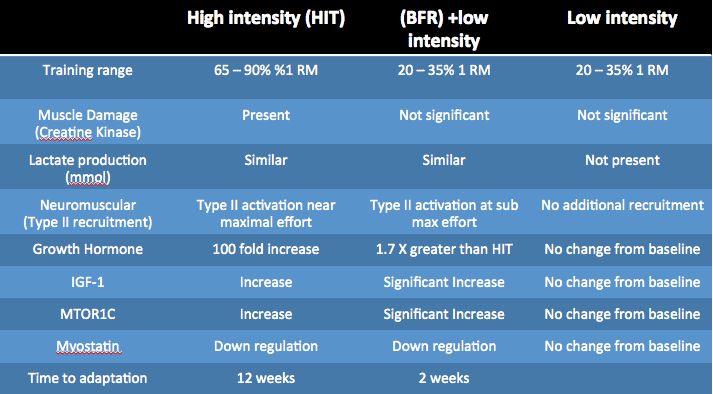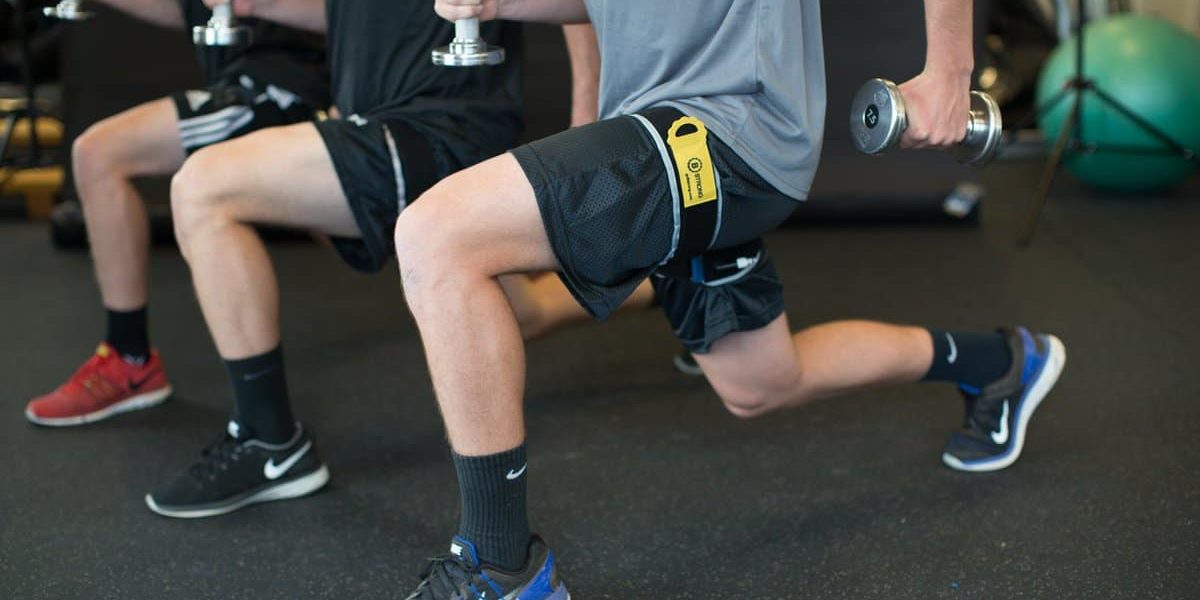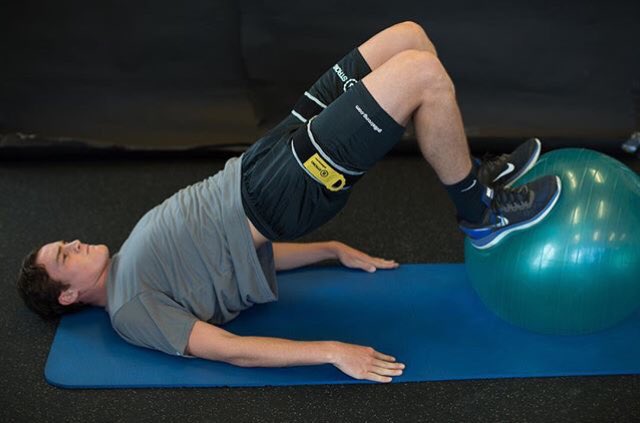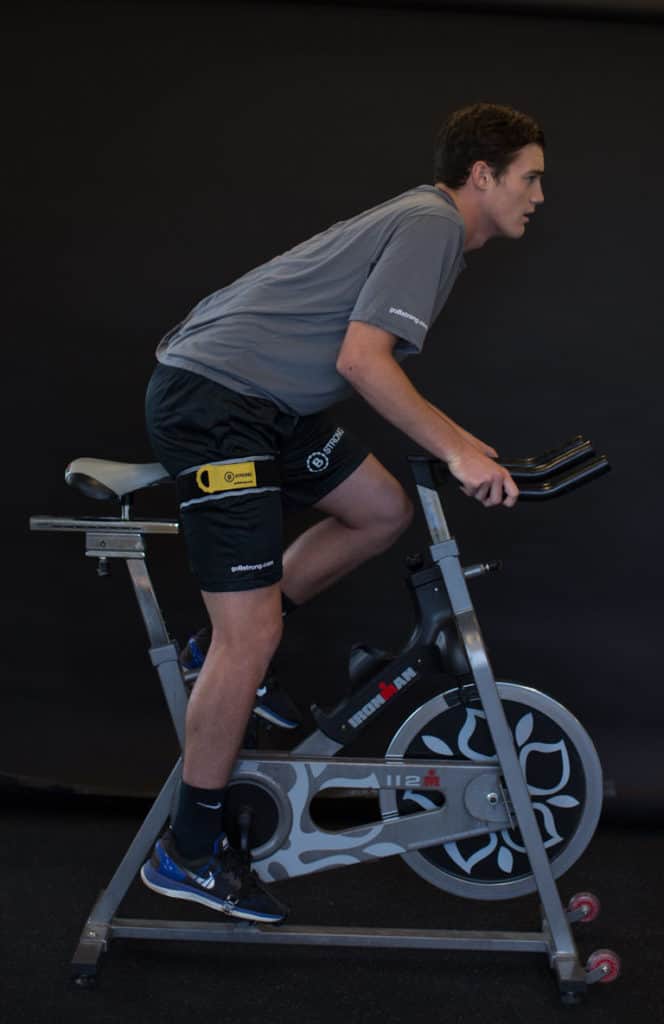Endurance, or the ability to continue despite fatigue, is a characteristic of sports performance that has been heavily discussed over the years.
Whether you’re a triathlete or CrossFitter, optimizing endurance is often the key ingredient that elevates an athlete from mediocrity to greatness, while also enhancing health and longevity.
However, building and improving endurance can be extremely complicated and difficult to program for effectively.
The goal of this series is not to discuss endurance training and programming, specifically, but instead to highlight some often underutilized aspects of training that can improve endurance.
This article highlights some of the endurance benefits of: blood-flow restriction training.
What is blood-flow restriction (BFR) training?
Blood flow restriction (BFR) training, also known as occlusion or KAATSU training, is a training strategy involving the use of cuffs or wraps placed around a limb during exercise to maintain arterial inflow to the muscle while preventing venous return.
The primary goal with BFR training is to slow down the rate at which blood returns from the muscles to the heart and cause blood to remain inside your muscles for longer than normal.
BFR can be used with resistance training, or with other modalities, including endurance activities such as walking and cycling.
When combined with exercise (and even without it) BFR magnifies the metabolic stress of exercise. Essentially, it’s similar to rest-pause training and, in a sense, “tricks” your muscles into thinking you’re using much heavier weights and working harder than you really are.
The majority of the research looking at BFR training has dealt with muscle strength and hypertrophy and the results are overwhelmingly positive. However, in addition to these muscular benefits, BFR has been shown to improve endurance, as well.
BFR works in several different ways and has numerous benefits, but for simplicity purposes, here’s a brief summary:
- Rise in growth hormone
- Rise in GH 290% higher than baseline with BFR.
- Growth hormone is important with recovery and healing, not muscle hypertrophy or protein synthesis.
- Lactate acid and hydrogen ion accumulation augments GH release.
- Contrary to popular belief, growth hormone is not involved in protein synthesis or muscle hypertrophy. Instead, it serves a protective role for tendons and muscle collagen structures as it increases collagen synthesis. This has important rehab from injury implications as well as making BFR a great tool for recovery in athletes.
- Increased IGF-1
- IGF-1 is a regulator of muscle mass and mediator of growth hormone. More IGF-1 means you can synthesize more protein and protein synthesis
- Basically, BFR doesn’t create significant muscle damage with the added muscle protein synthesis.
Muscle growth formula:
Net protein balance = muscle protein synthesis – muscle protein breakdown
A large increase in protein synthesis with little muscle damage means we are putting the body in a very good place for building muscle!
-
- Hypertrophy training with BFR, increases IGF-1 more than when compared to high intensity.
- This creates a signaling pathway for protein synthesis which can improve systemic muscular hypertrophy.
- BFR will even cause proximal gains, not just gain distal to the cuff of where it’s applied on the body.
- Cellular swelling
- Resistance training causes cells to expand and fill with fluid and nutrients, and it too acts as a signal for muscle growth.
- BFR training magnifies the muscle-building power of this, too, by increasing the amount of time that your muscle cells stay swollen.
- mTOR
- Research also shows that blood flow restriction can enhance certain genetic signalling pathways involved in muscle growth. You see, your body uses a complex network of chemical messengers to tell cells to grow or shrink. One of them that says “grow” is the protein called the mammalian target of rapamycin (mTOR), and one that says “shrink” is the protein myostatin.
- Studies show that blood flow restriction training increases levels of mTOR and lowers myostatin levels, which creates an environment in your body more conducive to muscle growth.
- No muscle breakdown or muscle soreness
- As mentioned before, low-load BFR training will not cause breakdown, or delayed-onset muscle soreness, but will result in positive collagen turnover, which is essential for healing and recovery.
- With traditional resistance training, an inflammatory cascade follows to build muscle.
- During BFR, measures of muscle damage such as creatine kinase, lipid peroxides, torque output of muscles, and delayed onset muscle soreness (DOMS) are minimally elevated. Meaning in our muscle growth formula, we don’t have muscle protein breakdown!
BFR + exercise = strength gain in low intensity exercise
Here’s a recap, taken from liftersclinic.com:

Blood-Flow Restriction Training
Great it builds muscle, but how can it improve endurance?
During blood flow restriction training, limited oxygen to the muscle means that the slow-twitch, Type I muscle fibers aren’t very active as they require oxygen as fuel.
Instead, the bigger, faster Type II, anaerobic muscle fibers are recruited. To recruit Type II muscle fibers during traditional resistance exercises we usually need to perform exercises at very high intensity. But the oxygen limitations flip that upside down!
As seen in the image above, when BFR is combined with low-intensity exercise, we’re able to create lactate production similar to HIT, but without the added muscle damage.
Therefore, endurance athletes will benefit more than sprint athletes as they rely more heavily on oxygen delivery. The effects of low-intensity resistance exercise with BFR are greater in endurance runners according to higher aerobic capacity.
While it has a bad reputation, lactate itself is not a bad thing. Lactate does not cause fatigue, but there is an association between the point that lactate levels elevate and fatigue.
The main objectives of high-intensity training are both to increase the production of lactate and, more critically, increase your body’s ability to clear the lactate. BFR allows us to train this effectively without the side effects of HIT.
Join the Pure Physio Newsletter!
In terms of building bigger and better “blood pumps”, BFR does that, as well.
Angiogenesis, or the development of new blood vessels, is a process that normally takes place with training. It’s triggered by gene expression and it’s more likely to occur after endurance-based training. Blood flow restriction training, however, seems to trigger this process in a more specific, localized manner by means of resistance training. It’s, in essence, the pinnacle of isolation training for general endurance purposes.
More capillaries available means two things: more oxygen and less waste product during prolonged, aerobic training and/or between bursts of high-intensity anaerobic training.
Over the long distance, this means more significant improvements in terms of VO2Max and/or more volume in terms of heavy strength training. Better VO2Max and higher tonnage ultimately lead to better improvements in strength, power, and endurance.
BFR can increase VO2 max and hypertrophy both at the same time. No other training will provide this benefit.
It’s an investment in the body’s physiological resources to create the foundation for a higher level of functional adaptation. As any other process involving tissue re-modeling, BFR training takes quite a long time to create a long-lasting adaptation.
BFR fits well in GPP programs for athletes, being the main goal an overall improvement in work capacity. It can also be used to improve power endurance later on during the season as it creates a situation of intense acidosis, strategically pre-fatiguing the muscles.
BFR has been shown to reduce stroke volume and increase heart rate in participants. A significant increase in blood pressure coincides with these previously mentioned factors to help positively affect the cardiovascular system and consequently increase cardiovascular endurance.
The novelty of BFR appears to be the unique combination of venous blood volume pooling and restricted arterial blood inflow, which can result in a decreased stroke volume and increased HR while maintaining cardiac output. Consequently, increased HR at the same systolic blood pressure (SBP) during exercise with BFR may produce high mechanical stress on the heart, as indicated by a greater rate-pressure product.
BFR vs traditional strength training:
- High intensity training with supplemental BFR the most effective when compared to either used individually.
- Studies show improved time to reach improved strength gains when BFR used supplementally with strength training.
Even BFR walk training represents a singular training methodology for improving aerobic capacity, endurance and muscular size at low training volumes and intensities. This may be beneficial for individuals undertaking concurrent strength and endurance training.
How can we implement it into training?
Usually, we’ll have our athletes use BFR training 2-4x/week, depending on the season and what their current training entails.
For example, on a deload week or recovery day, incorporating BFR is a great way to keep strength and hypertrophy going while allowing your body to recover.
To be competitive at the highest level, most athletes will be performing at least twice a day and, therefore, it is very difficult to add more training volume to his or her weekly schedule.
Using BFR work as a supplementary piece to accessory work will allow the athlete to address weaknesses and imbalances, but without the added volume, soreness and muscle damage that typical resistance training induces. As with most accessory work, the most effective strategy may be to use low load BFR AFTER high load high intensity training.
An example workout may look something like this:
For 5 rounds
-Cuffs on upper thighs
-Light spin on bike at 3/10 RPE for 2 min.
-20 air squats at a 2″ tempo
-Light walking for 1 min.
For the endurance athlete specifically, we’re looking for a maintenance of strength as your endurance training volume increases and reap the potential VO2max benefits. Cycle at 40% of your VO2max for 15 minutes. However, we know that even when combining BFR with walk training, we can have significant improvement in VO2max.
Training variables:
- Frequency: 2-4 days/week is sufficient to produce gains, as much as twice daily. Remember, you’re not getting muscle breakdown so you can do it more often.
- Cuff pressure:
- 80% occlusion lower body
- 50% upper body
- No return of blood out, small amount getting in.
- 4/10 pressure UE, 6-8/10 LE in terms of pressure
Whether its used with resistance training or endurance training, it’s important to remember to perform low intensity exercise and submaximal work when coupling BFR.
Low neurologic stress with BFR and low load resistance training – lower levels of muscle recruitment.
The majority of the research studies have found 75 reps to be the magic rep range with 150 being of no added benefit.
- 30-15-15-15 with 30” interval rest.
- 20-30% 1RM or 15-20 min at 40% VO2max
If the total of 75 reps cannot be completed, repeat the weight next workout (unless less than 50 reps were completed then lower the weight). If completing the 75 reps isn’t SIGNIFICANTLY hard, increase the resistance next time.
Other than that, general rules of weight and / or exercise progression are in play.
Overall, BFR training is a great supplementary tool and accessory device that research has shown can drastically improve endurance. At Pure Physio, we’re continuing to experiment and fine-tune their implementation into our programs.
However, if you’re interested in purchasing your own BFR cuffs for home use, we highly recommend using cuffs from Go B Strong. They’re safe, affordable and durable while also being extremely user- and travel-friendly.
Apply coupon code “purephysio” for 10% off your purchase.
For the next article in the series on alternative methods for improving endurance, we’re going to discuss: Polarized Training.
Until then,
Ryan





Besides training for athletic events, This sounds like a good option for persons with IS that have a difficult time getting strength gains secondary to joint pain. Any research on this population?
Hey Debi, I would have to agree. I have not seen the research on this population but I can see how applying BFR in combination with low intensity movements would be greatly beneficial.
Should have said OA not IS.
Wouldn’t the blood pooling effect be dangerous. with the possible f clotting/deep vein thrombosis?